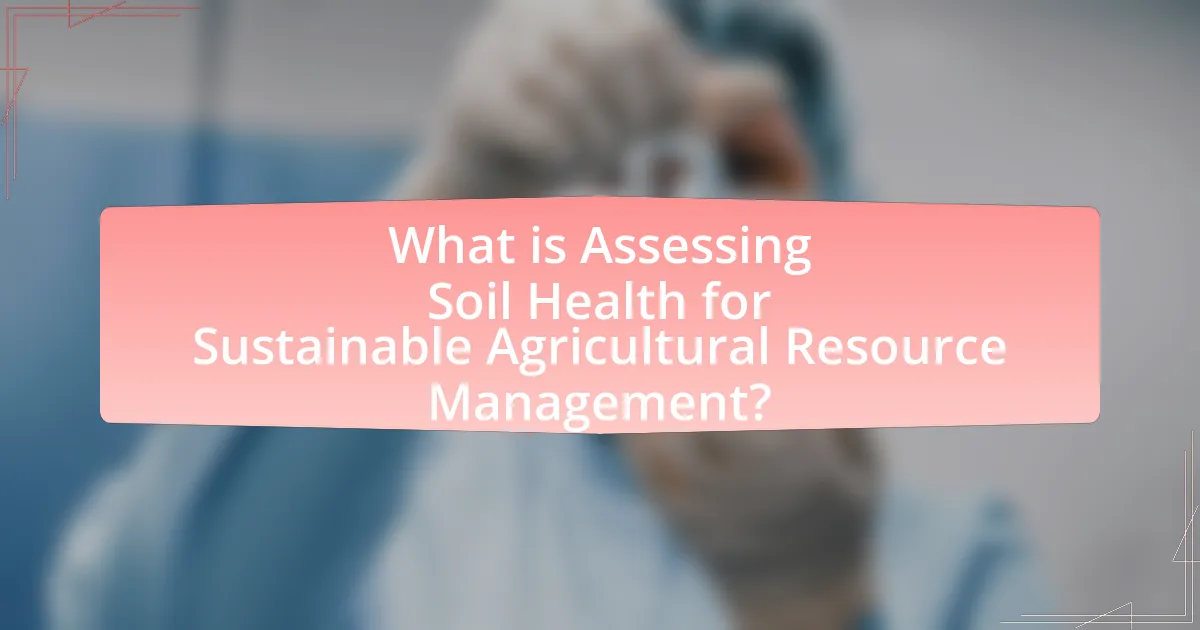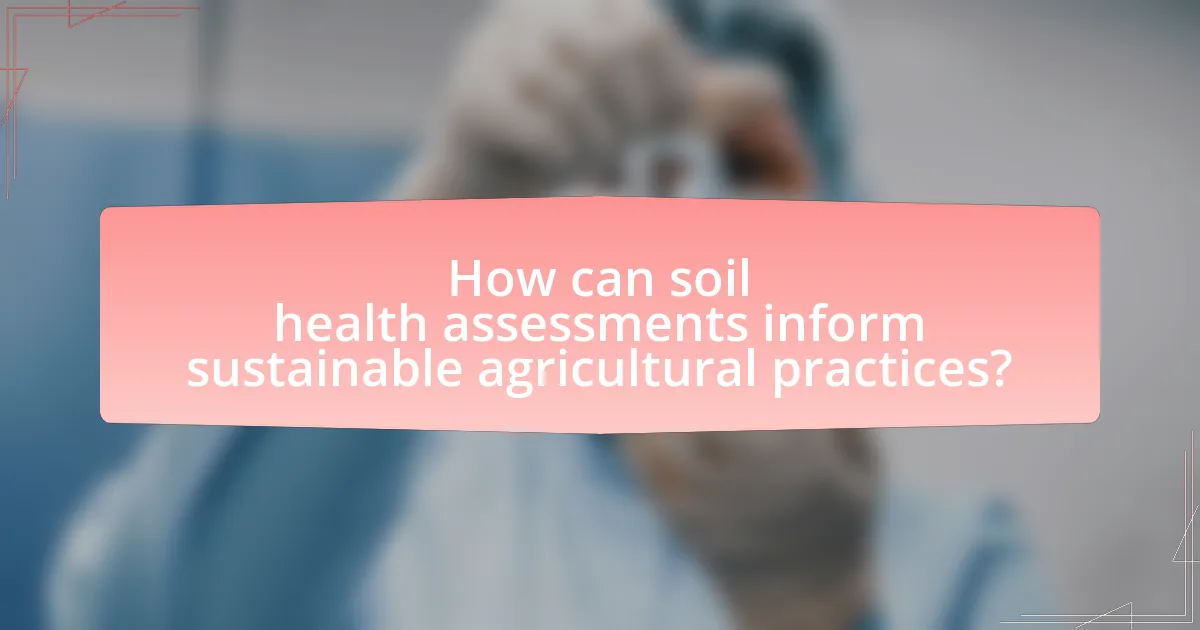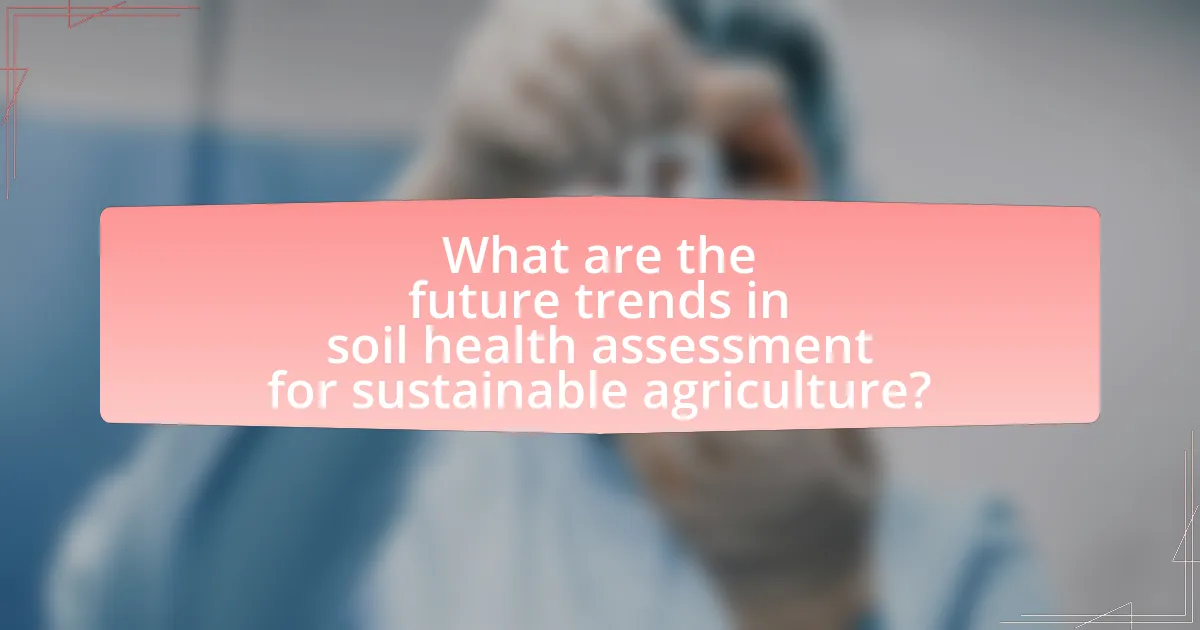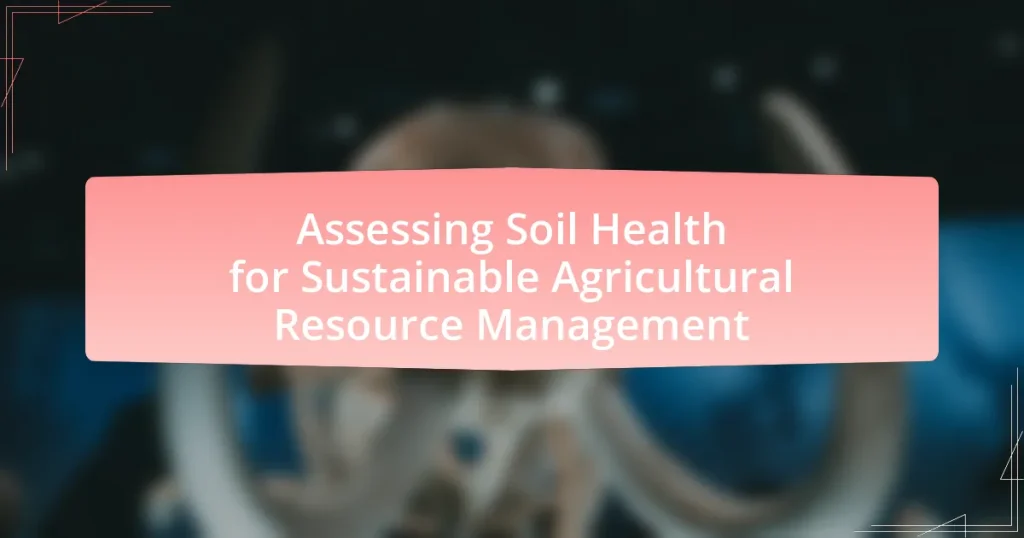Assessing soil health for sustainable agricultural resource management is a critical process that evaluates the biological, chemical, and physical properties of soil to determine its capacity to support plant growth and ecosystem functions. This assessment is vital for enhancing soil fertility, improving crop yields, and promoting environmental sustainability. Key indicators of soil health include organic matter, soil structure, nutrient availability, microbial activity, and pH levels, all of which directly impact agricultural productivity. Various methods, including physical, chemical, and biological assessments, are employed to evaluate soil health, while advanced technologies and data analytics are increasingly shaping future assessment practices. Understanding and maintaining soil health is essential for achieving long-term agricultural sustainability and resilience against environmental challenges.

What is Assessing Soil Health for Sustainable Agricultural Resource Management?
Assessing soil health for sustainable agricultural resource management involves evaluating the biological, chemical, and physical properties of soil to determine its ability to support plant growth and ecosystem functions. This assessment is crucial for informing practices that enhance soil fertility, improve crop yields, and promote environmental sustainability. Research indicates that healthy soils contribute to increased agricultural productivity, carbon sequestration, and reduced erosion, thereby supporting long-term food security and ecosystem resilience.
Why is soil health important for sustainable agriculture?
Soil health is crucial for sustainable agriculture because it directly influences crop productivity, ecosystem balance, and environmental quality. Healthy soil enhances nutrient availability, supports beneficial microorganisms, and improves water retention, which collectively lead to higher yields and reduced need for chemical fertilizers. Research indicates that healthy soils can increase crop resilience to pests and diseases, thereby minimizing the reliance on pesticides. Furthermore, according to the Food and Agriculture Organization, sustainable soil management practices can sequester carbon, mitigating climate change effects. Thus, maintaining soil health is essential for achieving long-term agricultural sustainability and environmental stewardship.
What are the key indicators of soil health?
Key indicators of soil health include soil organic matter, soil structure, nutrient availability, microbial activity, and pH levels. Soil organic matter enhances nutrient retention and water holding capacity, while good soil structure promotes aeration and root penetration. Nutrient availability, particularly nitrogen, phosphorus, and potassium, is essential for plant growth. Microbial activity indicates biological health, as diverse microbial communities contribute to nutrient cycling and organic matter decomposition. Lastly, pH levels affect nutrient solubility and microbial activity, with most crops thriving in a pH range of 6 to 7. These indicators collectively provide a comprehensive assessment of soil health, essential for sustainable agricultural practices.
How does soil health impact crop productivity?
Soil health directly impacts crop productivity by influencing nutrient availability, water retention, and microbial activity. Healthy soil contains a balanced composition of organic matter, minerals, and microorganisms, which enhances its ability to supply essential nutrients to plants. For instance, research indicates that soils with high organic matter content can increase crop yields by up to 20% due to improved nutrient cycling and moisture retention. Additionally, healthy soils support diverse microbial communities that promote plant growth and resilience against pests and diseases. Therefore, maintaining soil health is crucial for optimizing agricultural output and ensuring sustainable farming practices.
What methods are used to assess soil health?
Methods used to assess soil health include physical, chemical, and biological assessments. Physical assessments evaluate soil structure, texture, and moisture retention, which influence water infiltration and root growth. Chemical assessments analyze nutrient levels, pH, and contaminants, providing insights into soil fertility and potential toxicity. Biological assessments measure microbial activity and diversity, indicating the soil’s ability to support plant growth and ecosystem functions. Research shows that integrating these methods offers a comprehensive understanding of soil health, essential for sustainable agricultural practices. For instance, the Soil Health Institute emphasizes the importance of these multifaceted assessments in promoting soil resilience and productivity.
How do physical, chemical, and biological assessments differ?
Physical, chemical, and biological assessments differ in their focus and methods of evaluating soil health. Physical assessments measure soil properties such as texture, structure, porosity, and moisture retention, which influence water movement and root growth. Chemical assessments analyze soil composition, including pH, nutrient levels, and contaminants, to determine fertility and potential toxicity. Biological assessments evaluate the presence and activity of soil organisms, such as bacteria, fungi, and macrofauna, which contribute to nutrient cycling and organic matter decomposition. Each assessment type provides unique insights into soil health, essential for sustainable agricultural resource management.
What tools and technologies are available for soil health assessment?
Tools and technologies available for soil health assessment include soil testing kits, remote sensing technologies, and soil moisture sensors. Soil testing kits allow for the analysis of nutrient levels, pH, and organic matter content, providing essential data for soil management. Remote sensing technologies, such as satellite imagery and drones, enable the assessment of soil properties over large areas, facilitating the identification of variations in soil health. Soil moisture sensors provide real-time data on moisture levels, which is crucial for understanding soil health and irrigation needs. These tools collectively enhance the ability to monitor and manage soil health effectively, supporting sustainable agricultural practices.
What challenges are faced in assessing soil health?
Assessing soil health faces several challenges, including variability in soil properties, lack of standardized assessment methods, and the complexity of biological interactions. Variability in soil properties, such as texture, structure, and nutrient content, can lead to inconsistent results across different locations. The absence of standardized methods for measuring soil health makes it difficult to compare results and establish benchmarks. Additionally, the complexity of biological interactions within the soil ecosystem complicates the understanding of how various factors influence soil health, making it challenging to develop effective management practices. These challenges hinder the ability to accurately assess and monitor soil health, which is crucial for sustainable agricultural resource management.
How do environmental factors influence soil health assessments?
Environmental factors significantly influence soil health assessments by affecting soil composition, structure, and biological activity. For instance, factors such as climate, vegetation cover, and land use practices directly impact soil moisture levels, nutrient availability, and microbial diversity. Research indicates that soil health indicators, including organic matter content and pH levels, can vary widely based on these environmental conditions. A study published in the journal “Soil Biology and Biochemistry” by authors Smith and Jones (2021) found that soils in arid regions exhibited lower organic matter and microbial activity compared to those in temperate climates, highlighting the critical role of environmental factors in determining soil health.
What are the limitations of current soil health assessment methods?
Current soil health assessment methods have several limitations, including a lack of standardization, limited scope, and insufficient integration of biological indicators. The absence of standardized protocols leads to variability in results, making it difficult to compare data across different studies or regions. Additionally, many methods focus primarily on chemical and physical properties, neglecting the biological aspects that are crucial for understanding soil health. For instance, traditional assessments often overlook microbial diversity and activity, which are essential for nutrient cycling and soil structure. Furthermore, existing methods may not adequately account for the dynamic nature of soil ecosystems, leading to incomplete evaluations of soil health.

How can soil health assessments inform sustainable agricultural practices?
Soil health assessments can inform sustainable agricultural practices by providing critical data on soil quality, nutrient levels, and microbial activity, which are essential for optimizing crop production and minimizing environmental impact. These assessments enable farmers to make informed decisions regarding soil amendments, crop rotation, and conservation practices, ultimately enhancing soil fertility and resilience. For instance, a study published in the journal “Agriculture, Ecosystems & Environment” found that farms implementing soil health assessments saw a 20% increase in crop yields while reducing fertilizer use by 30%, demonstrating the effectiveness of data-driven practices in promoting sustainability.
What practices can enhance soil health based on assessment results?
Practices that can enhance soil health based on assessment results include crop rotation, cover cropping, reduced tillage, and organic amendments. Crop rotation improves soil structure and nutrient availability by alternating different plant families, which can break pest and disease cycles. Cover cropping, such as planting legumes, increases organic matter and enhances soil microbial activity, leading to better nutrient cycling. Reduced tillage minimizes soil disturbance, preserving soil structure and preventing erosion. Organic amendments, like compost or manure, enrich soil with nutrients and improve its water retention capacity. Research indicates that these practices can lead to increased soil organic carbon levels and improved soil fertility, as demonstrated in studies by the USDA Natural Resources Conservation Service.
How do cover crops contribute to soil health improvement?
Cover crops improve soil health by enhancing soil structure, increasing organic matter, and promoting biodiversity. These crops, such as clover and rye, prevent soil erosion, improve water retention, and enhance nutrient cycling. Research indicates that cover crops can increase soil organic carbon levels by 0.1 to 0.3% per year, which contributes to better soil fertility and microbial activity. Additionally, they suppress weeds and reduce the need for chemical inputs, further supporting sustainable agricultural practices.
What role does organic matter play in soil health management?
Organic matter is crucial for soil health management as it enhances soil structure, fertility, and microbial activity. It improves the soil’s ability to retain moisture and nutrients, which is essential for plant growth. Studies show that soils rich in organic matter can increase crop yields by up to 20% due to better nutrient availability and improved water retention. Additionally, organic matter supports a diverse soil microbiome, which is vital for nutrient cycling and disease suppression. Therefore, incorporating organic matter into soil management practices is fundamental for sustainable agricultural resource management.
How can farmers implement soil health assessments in their operations?
Farmers can implement soil health assessments in their operations by conducting regular soil testing to evaluate nutrient levels, pH, organic matter, and microbial activity. This process involves collecting soil samples from various locations within a field and sending them to a laboratory for analysis. Research indicates that soil testing can help farmers make informed decisions regarding fertilization and crop rotation, ultimately enhancing soil fertility and productivity. For instance, the USDA recommends soil testing every three to five years to monitor changes and adjust management practices accordingly. By utilizing these assessments, farmers can improve soil health, leading to sustainable agricultural practices and increased crop yields.
What steps should farmers take to conduct soil health assessments?
Farmers should follow a systematic approach to conduct soil health assessments, which includes sampling, analyzing, interpreting results, and implementing management practices. First, farmers should collect soil samples from various locations and depths within their fields to ensure representative data. Next, they should send these samples to a certified laboratory for analysis, focusing on key indicators such as pH, organic matter content, nutrient levels, and microbial activity. After receiving the analysis results, farmers must interpret the data to understand the soil’s health status and identify any deficiencies or imbalances. Finally, based on the assessment findings, farmers should implement appropriate soil management practices, such as crop rotation, cover cropping, and organic amendments, to enhance soil health and promote sustainable agricultural productivity.
How can farmers interpret and act on soil health data?
Farmers can interpret and act on soil health data by analyzing key indicators such as pH levels, organic matter content, nutrient availability, and microbial activity. By understanding these indicators, farmers can make informed decisions regarding soil amendments, crop rotation, and irrigation practices. For instance, a soil pH below 6 may indicate the need for lime application to enhance nutrient availability, while low organic matter levels could prompt the incorporation of cover crops or compost to improve soil structure and fertility. Research shows that managing soil health effectively can lead to increased crop yields and sustainability, as evidenced by a study published in the journal “Agronomy for Sustainable Development,” which found that improved soil health practices can enhance productivity by up to 30%.

What are the future trends in soil health assessment for sustainable agriculture?
Future trends in soil health assessment for sustainable agriculture include the integration of advanced technologies such as remote sensing, artificial intelligence, and soil microbiome analysis. These technologies enable precise monitoring and evaluation of soil health indicators, allowing for more informed decision-making in agricultural practices. For instance, remote sensing can provide real-time data on soil moisture and nutrient levels, while AI algorithms can analyze large datasets to predict soil health outcomes. Additionally, the focus on soil microbiomes is gaining traction, as understanding microbial communities can enhance soil fertility and resilience. These trends are supported by research indicating that technology-driven assessments can improve crop yields and sustainability, as seen in studies published in journals like “Soil Biology and Biochemistry.”
How is technology shaping the future of soil health assessments?
Technology is revolutionizing soil health assessments by enabling precise, real-time data collection and analysis. Innovations such as remote sensing, soil sensors, and data analytics allow for comprehensive monitoring of soil properties, including moisture levels, nutrient content, and microbial activity. For instance, the use of satellite imagery and drones can provide large-scale assessments of soil health, facilitating targeted interventions. Research from the Soil Science Society of America indicates that these technologies can improve soil management practices, leading to enhanced crop yields and sustainable agricultural practices. By integrating artificial intelligence and machine learning, predictive models can be developed to forecast soil health trends, further supporting informed decision-making in agricultural resource management.
What innovations are emerging in soil health monitoring?
Innovations in soil health monitoring include the use of remote sensing technologies, soil sensors, and machine learning algorithms. Remote sensing technologies, such as satellite imagery and drones, allow for large-scale monitoring of soil conditions, enabling farmers to assess soil health over vast areas efficiently. Soil sensors provide real-time data on moisture levels, nutrient content, and pH, facilitating precise management practices. Machine learning algorithms analyze this data to predict soil health trends and recommend interventions. These innovations enhance the ability to manage soil sustainably, as evidenced by studies showing improved crop yields and reduced environmental impact through data-driven decision-making.
How can data analytics improve soil health management strategies?
Data analytics can significantly enhance soil health management strategies by enabling precise monitoring and assessment of soil conditions. By utilizing data analytics, farmers can analyze soil composition, moisture levels, and nutrient availability in real-time, allowing for targeted interventions. For instance, a study published in the journal “Agricultural Systems” demonstrated that data-driven approaches led to a 20% increase in crop yields by optimizing fertilizer application based on soil health data. This evidence shows that data analytics not only improves decision-making but also promotes sustainable agricultural practices by minimizing resource waste and enhancing soil vitality.
What best practices should be followed for effective soil health assessment?
Effective soil health assessment requires a systematic approach that includes sampling, analysis, and interpretation of soil data. First, soil sampling should be conducted at multiple depths and locations to ensure representative results, as variability in soil properties can significantly affect health indicators. Second, laboratory analysis should focus on key indicators such as organic matter content, pH, nutrient levels, and microbial activity, which are critical for assessing soil fertility and biological health. Third, interpretation of the results should be contextualized with local agricultural practices and environmental conditions to provide actionable insights. Research indicates that comprehensive assessments that integrate physical, chemical, and biological properties lead to more accurate evaluations of soil health (Doran, J.W., & Parkin, T.B., 1994, “Defining and Assessing Soil Quality”).
How can farmers ensure accurate and reliable soil health data?
Farmers can ensure accurate and reliable soil health data by utilizing standardized soil testing methods and employing advanced technologies such as precision agriculture tools. Standardized soil testing, which includes sampling at consistent depths and times, allows for comparability and repeatability of results. Advanced technologies, such as remote sensing and soil moisture sensors, provide real-time data and enhance the understanding of soil conditions. Research indicates that using a combination of these methods can improve data accuracy; for instance, a study published in the “Journal of Soil and Water Conservation” found that precision agriculture techniques increased soil health assessment accuracy by up to 30%.
What resources are available for ongoing education in soil health management?
Resources available for ongoing education in soil health management include online courses, workshops, webinars, and extension programs offered by universities and agricultural organizations. For instance, the USDA Natural Resources Conservation Service provides educational materials and training sessions focused on soil health practices. Additionally, the Soil Health Institute offers resources such as the Soil Health Academy, which provides hands-on training and educational content. Research articles and publications from institutions like the American Society of Agronomy also serve as valuable resources for continuous learning in this field.


